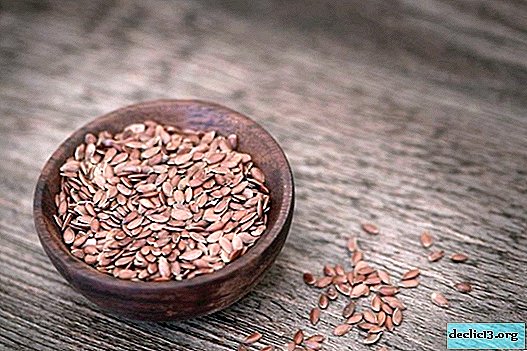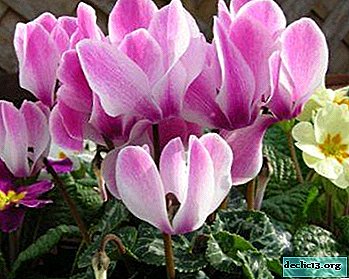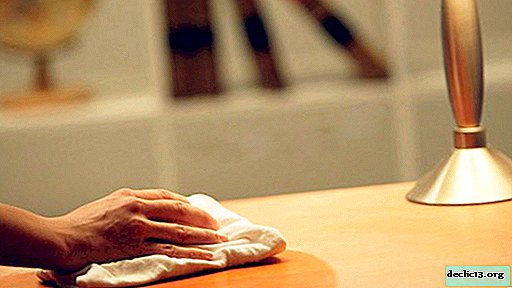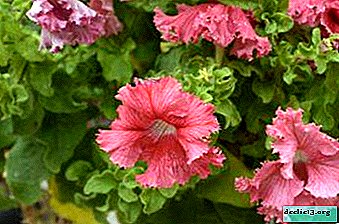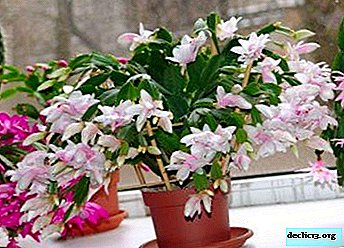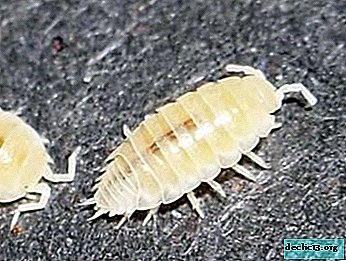How to grow marsh hibiscus: important rules for care, pruning and transplanting for plentiful flowering

Most of the 250 species of the hibiscus genus grow in the tropics and subtropics and are represented by tree forms and shrubs. An interesting North American representative of the genus is marsh hibiscus.
This herbaceous perennial plant, suitable for growing not only indoors, but also in the garden. Caring for it has specific nuances.
Botanical Description
Marsh hibiscus (Hibiscus moscheutos) - a representative of the family malvaceae. Other names: grass hibiscus, pink mallow, marsh mallow, musk hibiscus, common hibiscus. The word "hibiscus" in Greek means a flower similar to an ibis bird. "Moschus" means Latin musk.Swamp Hibiscus - a flowering herbaceous perennial resistant to cold. In nature, grows in wetlands and along river systems in wetland ecotopes, forms large thickets in wet meadows. Distribution geography - the eastern part of the USA, from Ontario to Florida, the Mississippi River Basin.
Under favorable conditions, the plant reaches 2.7 m in height. Stems erect, with time in the lower part covered with dark bark. Leaves are often deltoid with three lobes, petiolate, pubescent below. The flowers are single, five-petalled, 15-17 cm in diameter, with a variety of colors (from white to purple). The middle of the flower resembles a funnel, usually dark burgundy.
Photo
Below you will see photos of this plant:




How to care at home?
Marsh hibiscus is a popular garden plant suitable for marsh gardens or water bodies. Varieties that can be successfully grown indoors are bred. They reach smaller sizes, bloom not as plentifully as garden forms, and require specific growing conditions.
Temperature
- In summer, the optimum temperature for marsh mallow is 25-28 ° С.
- In winter, she needs a rest period, so the temperature should be reduced to 15 ° C.
Heavy watering
In summer, the plant is often watered with soft, settled water, regularly sprayed. So that the roots do not sour, when planting, care should be taken about good drainage. In winter, watering is somewhat reduced.
Bright lighting
The plant is photophilous. In the open air, it withstands direct sunlight, but indoors it requires light shading. On the western and eastern windows can be grown in direct sunlight.
Light and nutritious substrate
Neutral or slightly acidic soil is suitable for planting marsh hibiscus. It is better to use a mixture of sand and peat 1: 1. The pot for a young plant should be at least 15 cm in diameter, deep enough to allow good drainage.
Transplant and top dressing
 Hibiscus is a fast-growing plant, transplantation is carried out every six months. To do this:
Hibiscus is a fast-growing plant, transplantation is carried out every six months. To do this:
- pick up a pot 2 cm larger in diameter than the previous one;
- lay drainage from perlite, pebbles or wood bark;
- gently move the plant from the old pot to the new one by shaking the soil residues from the root system (remove damaged sections of the rhizome);
- fill the pot with a substrate, pour plenty of warm water.
Swamp hibiscus does not tolerate an excess of fertilizers; it is fed twice a year with phosphate-potassium fertilizers. It is better to use special preparations for flowering plants.
Pruning and wintering
In marsh mallow, flowers are formed at the tops of shoots, so timely pruning will increase the flowering.Trimming procedure:
- prepare the tool: wipe the sharp knife with alcohol or calcine;
- cut off the tops of shoots at a height of 40-60 cm;
- temporarily reduce watering and leave the plant alone for several days (do not rearrange, do not feed, do not create sudden changes in temperature);
- cut tops of shoots can be used for cuttings.
Some varieties of marsh hibiscus before wintering fall into a state of deep dormancy, their aboveground part dies. They need to provide a cool environment. Watering is reduced to 1 time in 1-2 weeks. Garden forms are winter-hardy, but it is better not to leave indoor varieties outdoors in the winter.
Before wintering, sanitary pruning is performed, old and diseased shoots are removed. In spring, forming trimming is carried out according to the above scheme. During the flowering period, wilted flowers should be constantly removed to stimulate the appearance of new ones.
Propagation Features
For the reproduction of marsh mallow, seeds, stem cuttings and rhizome fragments are used. It is important to remember that hybrid forms retain all decorative features only during vegetative propagation.
Seeds

- Seeds should be scarified - scratch the hard shell, make a shallow incision or puncture.
- Then they are soaked for an hour in warm water for swelling and sown in soil to a depth of 1 cm, sprinkled with earth and moisten.
It is better to germinate seedlings under the film at a temperature of 25-30 ° C on the southern windows. Usually sprouts appear after 2 weeks.
We offer you to watch a video on how to sow the seeds of marsh hibiscus:
Cuttings
- The apical cuttings are cut from young shoots. On a 15 cm long handle, 2 nodes with kidneys are left, the lower leaves are torn off.
- In the prepared mixture of sand and peat, the stalk is deepened by 5 cm.
We offer you to watch a video on the propagation of marsh hibiscus by cuttings:
Rhizome division
The rhizome of the marsh hibiscus is constantly growing, so it should be periodically divided into parts. The procedure is carried out 1 time in 5-10 years with a spring transplant. The new root top is planted in a separate pot, deepening by 5-8 cm.
Video on how to propagate the plant by dividing the rhizome:
Diseases and Pests
Improper care of the plant reduces its decorative effect. With an excess of nitrogen fertilizers, flowers do not form. With a lack of moisture, the leaves fall off, with a lack of minerals - fall off, curl, turn yellow. Twisted or deformed leaves are one of the signs of the appearance of insects.
The main pests:
- spider mite;
- aphid;
- thrips;
- whitefly.
To prevent their appearance, a hibiscus once a month is given a warm 10-minute shower, after wrapping the pot in a plastic bag.
5 similar flowers
Marsh Mallow has close relatives, from whom it is difficult to distinguish:

- hibiscus syrian (tree-like shrub with flowers up to 12 cm in diameter, leaves similar to chrysanthemum);
- Chinese rose (oval, jagged leaves, flowers reach 15 cm in diameter, double forms are common);
- variegated hibiscus (leaves are mottled with shades of red, white and green);
- Sudanese rose (oval leaves with denticles along the edges, flowers up to 20 cm in diameter);
- hibiscus hybrid (grassy perennial with huge spectacular flowers).
Most cultivated hibiscus species have both garden and pot forms. The abundance of moisture and sunlight allows you to successfully grow marsh hibiscus in indoor conditions. This plant is thermophilic, grows quickly and, with proper care, pleases with abundant flowering.
Interesting video
We offer you to watch a video with a description of the marsh hibiscus and the features of caring for it:




